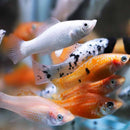Description
Mollies, scientifically known as Poecilia spp., are a diverse group of freshwater fish species that have been a staple in the aquarium hobby for many years. Their varied colors, adaptable nature, and ease of care have made them a favorite among aquarists. Mollies belong to the family Poeciliidae and are closely related to other popular livebearers like guppies and platies.
Physical Characteristics:
- Size: Mollies are small to medium-sized fish, typically growing to an adult size of 2 to 4 inches (5 to 10 centimeters), depending on the specific species and environmental conditions.
- Body Shape: They have a slender, elongated body shape with a slightly compressed appearance. Mollies exhibit sexual dimorphism, with males usually being more slender, and females having a plumper, rounded abdomen.
- Coloration: Mollies are known for their varied coloration. Common colors include black, white, gold, orange, and silver. Some species and variations also display vibrant hues like red, green, and blue.
- Finnage: Their dorsal fin is typically triangular, and they have an anal fin that may extend into a sword-like shape in some varieties, known as sailfin mollies.
Behavior and Temperament: Mollies are generally peaceful and sociable. They are suitable for community aquariums and get along well with a variety of other fish species. While males may occasionally engage in mild territorial disputes, serious aggression is rare.
Habitat and Tank Requirements:
- Tank Size: Mollies can thrive in tanks of varying sizes depending on the specific species and the number of fish kept. A 20-gallon (75-liter) aquarium is suitable for a small group of mollies, but larger tanks are preferable for larger populations.
- Substrate: Provide a soft substrate like sand or fine gravel to create a comfortable environment. Mollies appreciate a substrate that allows them to sift through for food.
- Filtration: Efficient filtration and maintenance of water quality are essential for mollies. They are sensitive to poor water conditions, so regular water changes are important.
- Decor: Furnish the aquarium with hiding spots such as plants, driftwood, rocks, and PVC pipes. Live or artificial plants can provide shelter and enhance the aesthetics of the tank.
- Water Parameters: Mollies thrive in tropical freshwater conditions with a temperature range of 72°F to 82°F (22°C to 28°C), a pH level between 6.5 and 8.0, and moderately hard water. Some species, like sailfin mollies, prefer brackish water conditions.
Diet: Mollies are omnivorous and have a varied diet. Offer them high-quality flakes, pellets, and granules formulated for omnivorous fish. They also enjoy live or frozen foods like brine shrimp, daphnia, and bloodworms. Supplement their diet with vegetable matter, such as blanched spinach or spirulina flakes.
Breeding: Mollies are livebearers, meaning they give birth to live fry rather than laying eggs. Breeding mollies is relatively straightforward, and they can reproduce readily in captivity. Provide them with ample hiding spots and monitor the pregnant females for the birth of the fry. Newly born fry are typically independent and can be raised with proper care.
Payment & Security
Your payment information is processed securely. We do not store credit card details nor have access to your credit card information.


